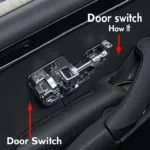Understanding the OBD2 protocol list for Ford vehicles is crucial for effective diagnostics and troubleshooting. Whether you’re a professional mechanic or a DIY enthusiast, knowing which protocols your Ford uses allows you to choose the right OBD2 scanner and interpret the data correctly. This comprehensive guide will delve into the various OBD2 protocols used by Ford, helping you navigate the complexities of automotive diagnostics.
Ford, like other manufacturers, has adopted several OBD2 protocols over the years. These protocols dictate how the diagnostic tool communicates with the vehicle’s onboard computer. Identifying the correct protocol is the first step in successfully retrieving diagnostic trouble codes (DTCs) and monitoring vehicle performance. Knowing this information can save you time and frustration, ensuring you’re using the right tools and techniques for your specific Ford model. Want to learn more about OBD2 scanners? Check out our obd2 elm327 bluetooth guide.
Decoding the Ford OBD2 Protocol List
Different Ford models utilize various OBD2 protocols depending on their manufacturing year. Early models might use older protocols, while newer vehicles often employ more advanced communication systems. Here’s a breakdown of the common protocols found in Ford vehicles:
- SAE J1850 PWM (Pulse Width Modulation): This protocol is commonly found in older Ford models, particularly those manufactured before the mid-2000s.
- SAE J1850 VPW (Variable Pulse Width): Similar to PWM, VPW is another protocol used in older Ford vehicles.
- ISO 9141-2: This protocol is found in some European Ford models and is less common in North American vehicles.
- ISO 14230-4 KWP2000 (Keyword Protocol 2000): KWP2000 became more prevalent in Ford vehicles produced around the turn of the millennium.
- ISO 15765-4 CAN (Controller Area Network): CAN is the most common protocol in modern Ford vehicles. It offers faster communication and more data transfer capabilities.
 Ford OBD2 Protocols Chart
Ford OBD2 Protocols Chart
Understanding which protocol your Ford uses can be determined by checking the vehicle’s owner’s manual or using an OBD2 scanner that automatically detects the protocol.
Why Knowing the Right Protocol Matters
Using the correct protocol ensures seamless communication between your diagnostic tool and your Ford’s onboard computer. Choosing an incompatible scanner might lead to inaccurate readings or even an inability to connect. Imagine trying to decipher a message written in a language you don’t understand. Similarly, using the wrong OBD2 protocol can lead to confusing and misleading diagnostic results. For help with choosing the right OBD2 scanner, see our guide on obd2 диагностическое оборудование выбор.
How to Find Your Ford’s OBD2 Protocol
- Check the Owner’s Manual: The vehicle’s manual usually provides information on the OBD2 protocol used.
- Use an Automatic Detection Scanner: Many modern OBD2 scanners automatically detect the vehicle’s protocol upon connection.
- Online Resources: Several online databases and forums provide information on OBD2 protocols for different Ford models.
“Understanding OBD2 protocols is like knowing the language your car speaks,” says John Davis, a veteran automotive diagnostician. “It’s the key to unlocking valuable information about your vehicle’s health and performance.”
Common Ford OBD2 Issues
While OBD2 protocols are essential for diagnostics, sometimes issues can arise. Here are a few common problems and potential solutions:
- Communication Errors: Ensure the OBD2 scanner is compatible with your Ford’s protocol. Check for loose connections or damaged wiring.
- Inability to Read Codes: Try a different OBD2 scanner or consult a professional mechanic.
- Inaccurate Readings: Verify the scanner’s compatibility and check for any interference.
“Don’t let OBD2 issues frustrate you,” advises Maria Sanchez, a certified automotive technician. “With a little troubleshooting, you can get the information you need to keep your Ford running smoothly.” You can find more resources about OBD2 scanners on our unicarscan ucsi-2000 bluetooth obd2 adapter page.
Conclusion
Knowing the OBD2 protocol list for Ford vehicles is vital for effective diagnostics. By understanding these protocols, you can choose the right OBD2 scanner, retrieve accurate diagnostic trouble codes, and monitor your vehicle’s performance effectively. This knowledge empowers you to take control of your Ford’s maintenance and ensure its optimal performance. Are you experiencing issues with your 7.3 Ford? Check out our 7.3 obd2 won& 39 article for more information. Do you want to program a key chip? Read our elm327 obd2 used to program key chip guide.
Need help with your car diagnostics? Contact us via WhatsApp: +1(641)206-8880, Email: cardiagtechworkshop@gmail.com or visit us at 789 Elm Street, San Francisco, CA 94102, USA. We have a 24/7 customer support team ready to assist you.

